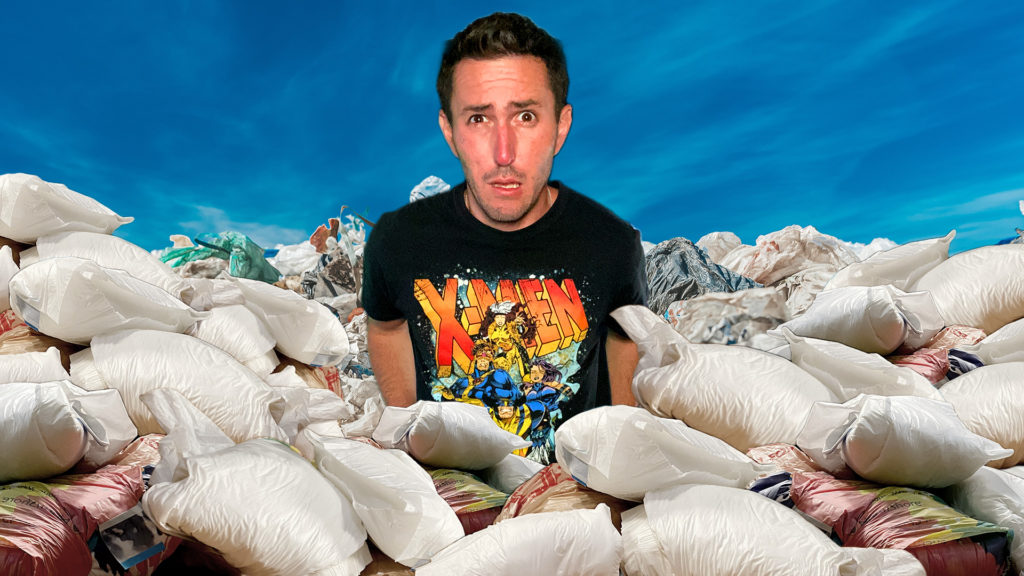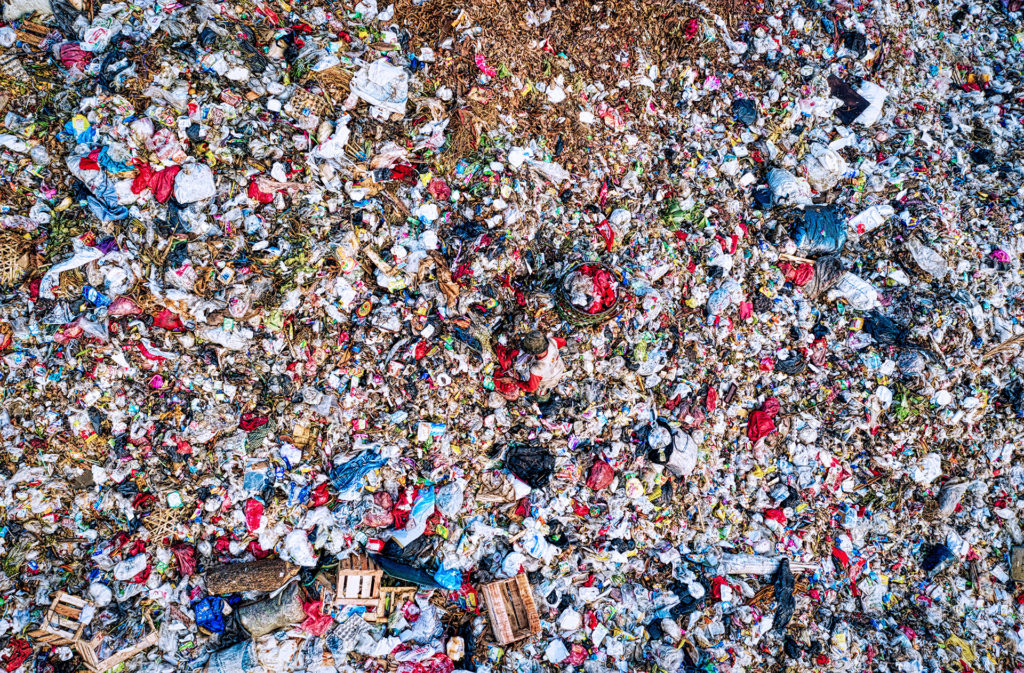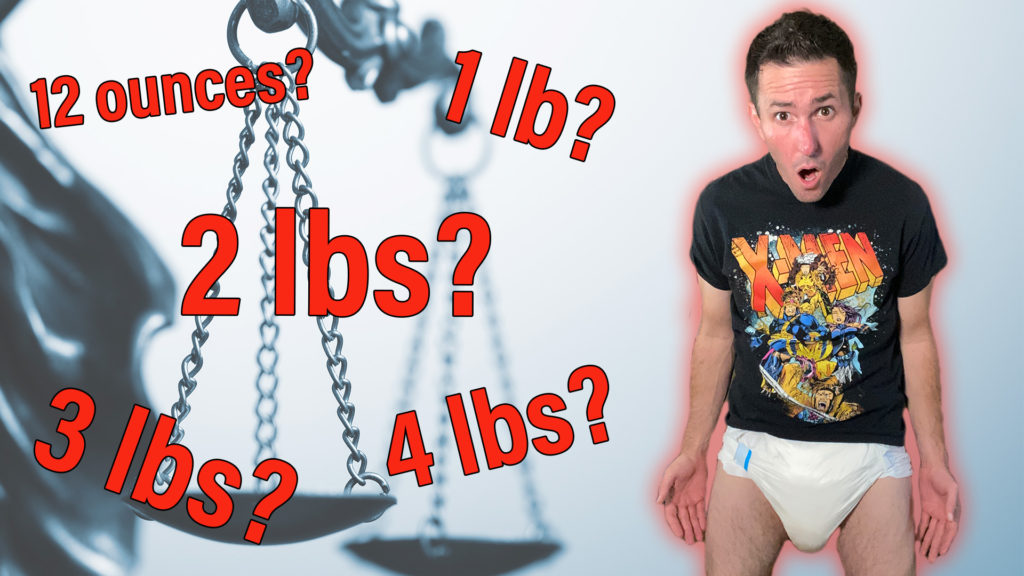As someone who has needed to wear diapers for many years I have always used disposable diapers for my needs.
I find them far more comfortable, far more effective, far more discreet, and just overall more efficient than any type of reusable cloth diaper I have ever tried.
While the waste caused by choosing to go with disposable diapers has always been a concern, it’s a concern that always has been something that has come secondary to my physical and psychological well being.
According to the most recent numbers by the EPA there was 4.1 million tons of disposable diapers that went to landfills as of 2018. According to the math I’m about to walk you through the reality may actually be double, triple, or even quadruple this officially stated number.

That said, it’s hard to go with any other option when disposable diapers are just an all around better user experience. For parents, caregivers, and those of us that need to wear them.
Now that I take a far more active role in supporting their use for a vast variety of needs that they help people with, across all ages, I naturally worry about the environmental impact of disposable diapers.
As a creator and “influencer” in this niche, if I’m going to be influencing people to choose diapers over other options I also need to be weary of the effect this will have on the planet.
The best way for me to understand that potential impact more deeply is to create content about it.
There Is HOW MUCH Disposable Diaper Waste?!?
They say disposable diapers are among the most common products found in landfills. Whose they though?
When searching across the internet we blog writers have a bad habit of plucking a number and then repeating it without ever questioning where it came from.
“THEY” say over 27.4 billion disposable diapers end up in landfills annually in the US alone. In this case the THEY in question is the Environmental Protection Agency.

That translates to over 4.1 million tons of diaper waste every year in the US. These are the hardest most up to date numbers I can find at the time of writing this and they go back to 2018. (it’s currently April 2023)
The disposable diaper market has continued to grow since then.
But HOW exactly are these numbers even calculated you ask?!? Great question! I was wondering that myself.
Diaper waste is typically measured, tracked, and calculated through waste management and disposal systems. In the case of disposable diapers, these are often sent to landfills, where their quantity can be measured and tracked through landfill weigh-ins and waste audits.
Waste audits involve manually sorting through a sample of waste and categorizing it by material type and source.
This allows waste managers to estimate the percentage of waste made up of diapers, as well as other materials like food waste, plastic, and paper.
These numbers are said to include adult incontinence products but as we are about to see I’m not entirely convinced that they give us the full picture.
In a lot of cases during these conversations disposable adult diapers aren’t usually mentioned or considered. I can only guess this stems from the secretive culture we have built up around needing to wear diapers.
This is another reason I work so hard to help people feel more comfortable talking about it. We can’t address a problem no one is willing to talk about or acknowledge exists.
Whether those are the problems that are causing so many people across all ages to experience incontinence to begin with or the potential waste problems that may arise as a result.
Then there is the increasing awareness that diapers are a valuable tool to help improve the lives of people in a variety of situations that go beyond incontinence issues.
People who experience an increased quality of life out of using diapers in any way should have the freedom to do so guilt free, shame free, and judgement free.
The only way I can see for that to ever be possible is if we start acknowledging and owning that this need exists.
Let’s talk about some ways we can possibly go about calculating just the potential adult diaper waste next.
How Much Does A Used Adult Diaper Weigh?

Since I am extremely skeptical of all the numbers I can find on this subject I want to take you with me on a journey towards seeing if we can figure out how big or small of a problem adult diaper waste might actually be.
To start with, let’s get a number for the average weight of a used adult diaper.
It’s important to note that the actual weight of a used adult diaper may vary pretty wildly depending on the type and brand of the diaper, as well as the amount of liquids or solids it contains.
I’ve gotten weights on used products between 12 oz and all the way up to 5 lbs. (without solid waste)
That said, I’ve explored dry weights and wet weights a lot in my work as a way to take a more practical approach towards the user experience. The most common weights for a good quality tape up diaper tends to be in the 2 lb to 3 lb range by the time a change is needed.
So according to the numbers I have recorded I have good reason to choose the 2.5 lb average as a rough estimate for an overall average for tape up diapers.
Now, if I were to consider the fact that there is probably a larger amount of people who have very minor issues that end up wearing the store brand types of pull ups that may bring the national average weight of a used adult diaper down to maybe 1.5 lbs.
Pull ups generally weigh 1.5 to 1.7 oz dry and somewhere around 12oz to 14oz wet. We would really need to play with the numbers, look at certain types of conditions that cause varying degrees of wetting to see how prevalent certain levels of wetting are to really hone in on some better averages.
This 1.5 lb average weight of a used adult diaper is merely an educated guess from my years of experience analyzing diapers at their performance.
Perhaps you think the average weight of a used adult diaper should be higher. Maybe you think it should be lower.
I think that this number is up for debate but this is just a way to get some sort of general idea of the potential waste problem we might need to solve.
As you’re about to see if we work with what I consider to be a some conservative estimates in all possible ways, the adult diaper waste problem is likely bigger than we are acknowledging.
A Way To Calculate Adult Diaper Waste

When it comes to how much potential waste the adult diaper market produces in comparison to the official numbers cited earlier I’ve done some “back of the envelop equations.“
Keep in mind that these equations are based off of a lot of rough estimates so it is likely this picture I’m about to paint is off by a decent amount.
That said if what I am about to show you is anywhere within the ball park of being correct you can understand my growing concerns over this issue. We’re going to do a bit of math but follow me through on this for a minute…
What is an equation we can use to calculate the potential tons of adult diaper waste per year in the U.S.?
If we assume that the average weight of a used adult diaper is 1.5 pounds, then we can calculate the number of used adult diapers needed to reach 4.1 million tons (the amount of waste the EPA cites as the amount of disposable diaper waste)of waste as follows:
- 1 ton = 2,000 pounds
- Therefore, 4.1 million tons = 8.2 billion pounds
- 1 used adult diaper = 1.5 pounds
- To calculate the number of adult diapers needed to reach 8.2 billion pounds of waste we can divide 8.2 billion lbs by 1.5:
8.2 billion lbs / 1.5 lbs per used diaper = 5.5 billion used adult diapers
Therefore, approximately 5.5 billion used adult diapers would need to be generated per year to reach the 4.1 million tons of waste that is commonly cited for disposable diapers.
This will be our basic benchmark for comparison. Does adult diaper use match or exceed 5.5 billion used diapers per year?
How Many Adults Have Incontinence Issues?
Now we can go ahead and work these numbers in a variety of ways to try and see how it compares with the often cited and reported 4.1 million tons for disposable diapers.
When attempting to find a solid number for how many adults in the U.S. use adult diapers this can be challenging in itself.
The National Association for Continence (NAFC) estimates that around 25 million Americans experience some form of urinary incontinence.
The NAFC arrives at this estimate through a combination of survey data and medical research.
According to the NAFC, around 80% of people with incontinence are women, and the condition becomes more common as people age.
However, incontinence issues can affect people of all ages and genders, and the exact number of people affected can be difficult to determine due to issues with underreporting and stigma.
Another number to look at is the number proposed here by the Urology Care Foundation. They state that “A quarter to a third of men and women in the U.S. suffer from urinary incontinence.”
That is a rather substantial claim to make. I have reached out to the Urology Care Foundation for further insight as to how they arrived at these numbers.
“A quarter to a third of men and women in the U.S. suffer from urinary incontinence.”
Urology Care Foundation
For greater context at 25% of all U.S. adults that puts us at 64.5 million adults with some form of incontinence issues!
If this is true this means that 1 in 4 people suffers with incontinence issues of some type!

If the actual number is more than this then I suspect the amount of total disposable diaper waste going to landfills is significantly larger than what is commonly thought.
Now that we have some idea of how many adults in the U.S. have incontinence issues next we need to figure out how many of them might choose to wear diapers or pull ups for their issues.
How Many Adults ACTUALLY Wear Diapers?
Now that we have some rough estimates on how many adults may suffer from various different types of incontinence issues let’s explore how many of us there are making use of adult diapers.
What are all the factors we need to consider in order to arrive at the best estimate?
Well if we could get some gross sales numbers for the whole market that could give us at least one piece of the puzzle right?
According to globalnewswire.com in the year 2020 the U.S. sold 260 million units of adult diapers. It is a little unclear to me whether or not a unit in this case is a single diaper, a package of diapers, or a case of diapers.
I suspect a unit would probably be either a package or a case since diapers aren’t generally sold in singles.
- If a unit is a package then on the low end that would be 10 diapers per package. This would make 260 million units equal to 2.6 billion adult diapers.
- On the high end some brands have 15 to 20 diapers per package. At 15 diapers per package that comes out to 3.9 billion diapers. At 20 diapers per package it comes out to 5.2 billion adult diapers.
What if instead of packages of diapers some of the units also include whole cases of diapers? This would dramatically increase the potential number of diapers 260 million units would equal.
Just to give you an idea of how large the adult diaper market really is below you will find a table of every adult diaper brand currently or recently on the market that I can find.
A couple of them have been discontinued but they still would be in our landfills nonetheless.
| Depend | Tena | Always Discreet | Prevail | Attends |
| Tranquility | Poise | Abena | Molicare | Cardinal Health Wings |
| NorthShore | Unique Wellness | Seni | LivDry | Rearz |
| Bambino Diapers | Crinklz | Fabine | ABUniverse | Tykables |
| LittleForBig | Sunkiss | FitRight | First Quality | HealthDri |
| InControl | Vivactive Slip | McKesson | Medline | Select |
| StayDry | Cardinal Health | Presto | Molicare | Secure Personal Care |
| Reassure | BetterDry | ProCare | Beyond XP5000 | Dignity |
| LandOfGenie | Trest | Dotty Diaper Company | TotalDry | NappiesRUs |
| Mollis | Amazon Basics | Because | BrightCare | Novamed |
| ProHeal | Continuon | Made For Living | Diaper Connoisseur (discontinued) | Confidry 24/7 (discontinued) |
Keep in mind that many of the brand names listed here have more than one type of diaper or incontinence product they offer so as to accommodate the large variety of needs and tastes people have.
It is also likely there are many more brands than those listed here available internationally in other countries that aren’t showing up in my searches due to my location.
This is a growing market and it’s NOT just because of aging populations. That does have a big part to do with it but it certainly isn’t the only contributing factor.
There is an increasing rate of the prevalence of incontinence across all ages. Why this is and how prevalent it is I’m not entirely sure.
I just know that I speak largely to a demographic in the age range of 18-54.
Of course websites and content like the type I produce under The Diaper Dynamo brand across the internet are going to have some small effect on opening people up to diapers as a valid management option.
Increasing the amount of people who choose to wear diapers to manage their issues beyond what the current projections of market growth will be when people start to realize they are actually one of the best options for management.
This is the whole point of my efforts to de-stigmatize diapers as a valuable tool for improving people’s quality of life.
As stated earlier I also support people wearing diapers for whatever other reasons they may have beyond incontinence issues as long as it leads to a better life.
I’ve met people who wear diapers for mental health issues, for comfort, and even for pleasure. I’ve met people who wear diapers for a variety of all these reasons combined.
“There are many reasons people wear diapers but there really is only one, an improved quality of life.“
The Diaper Dynamo
How Much Adult Diaper Waste Is There?
While I’m not totally confident with all the different numbers we have collected thus far I think now that we have a variety of perspectives on what the potential numbers might be, we can do some calculations to figure out some rough estimates of how much disposable adult diaper waste there MAY ACTUALLY be going to landfills each year.
Let’s play with the numbers a bit and see if we can find any evidence on what the potential reality of this situation may be.
- If it is estimated 25 million adults in the United States experience some form of urinary incontinence, which can require the use of incontinence products such as diapers, we can make some calculations. If each of these adults required 3 diaper changes per day, this would result in approximately 68.25 billion diapers used per year. This would be almost 12 times the amount of wast of disposable diapers cited by the EPA!
- Lets do a low end calculation and say of those 25 million adults none of them have to wear diapers full time. They’re all bedwetters and only have to wear one diaper a day for when they go to sleep at night. This equals 9.125 billion adult diapers a year. In this case it is still higher than 5.5 billion adult diapers it would take to match the 4.1 million tons of disposable diapers cited by the EPA.
Now we must also consider there are many ways to address and manage incontinence issues. Not everyone is going to choose to go with diapers so these two calculations are nowhere near an accurate picture.
Perhaps some of us will only use them temporarily during a period of diagnosis and attempted treatments while we work to regain control.
Perhaps some will opt to try other forms of management like catheters, nerve stimulators, and other surgical procedures that would lead diapers to not be necessary.
So maybe of these 25 million adults 10 million of them use adult diapers to manager their issues full time while 6 million use them use diapers for bedwetting issues.
- If 10 million adults wear diapers full time that is going to be at least 3 used diapers a day on average. That’s 30 million used adult diapers a day and nearly 11 billion used adult diapers a year.
- If 6 million adults wear diapers just at night that 6 million used diapers a day and 2.2 billion used diapers per year.
- If we add these two groups together that brings us to 13.2 billon used diapers per year which is more than double the 5.5 billion number we came up with earlier that matches the most officially cited number for all types of disposable diaper waste.
Let us also keep in mind that those of us who wear full time and only need to change 3 times a day are using the types of tape up diapers that average 2.5 lbs used.
This is also true for the bedwetter calculation. It takes a much more absorbent and secure tape up diaper to make it through the night.
This means that both of these equations to need to use the 2.5 lb metric for how much this amount of diapers equals in weight. The 5.5 billion diaper number we came up with earlier was based on a 1.5 lbs per used diaper.
- 13.2 billion diapers X 2.5 lbs = 33 BILLION LBS!
- That’s 16 million tons of adult diaper waste!
So the overall waste in tons for just adult diapers is actually going to come out to quite a bit more than 4.1 million tons that everyone everywhere seems to cite.
Those who need to wear diapers full time may wear products that require 5 to 8 diaper changes a day. In these cases the diapers would likely weigh somewhere in between that that most absorbent diapers will hold VS what the far less absorbent pull ups will hold.
There will be days where those of us who wear the more absorbent products that will require only 3 changes a day have different things going on with our bodies that will require more than 3 changes that day.
All this leads to even these very conservative estimates being potentially much higher.
No Matter The Size Of The Disposable Diaper Waste Problem We Need Solutions
As mentioned before, the 25 million number itself is possible to be much lower than the actual number of people who may be suffering from various forms of incontinence issues.
If the Urology Care Foundation’s estimates are closer to the truth then we are working with the much larger number of 64.5 MILLION U.S. ADULTS!
Does that bring the number of full time diaper users up to 20 million or even 25 million? Does that mean that the number of bedwetters that wear diapers is closer to 12 million?
How about the people who don’t experience any loss of bladder control at all but instead wear diapers for symptom of overactive bladders because it helps to alleviate the constant stress of being worried about “what IF I have an embarrassing accident“.
Add to that that everyone’s needs are going to be different you can start to see how much more significant the disposable diaper waste problem might ACTUALLY be.
Whatever the actual size is of the problem, it seems to me like the reality of it is likely to be much larger than the “official” numbers we are being told about.
If this is indeed the case how do we go about solving it?
Even if this isn’t the case disposable diaper waste does need a better solution than simply being discarded into landfills where they can pollute our planet right? We are talking about human waste here.
Let’s talk about that next here!
